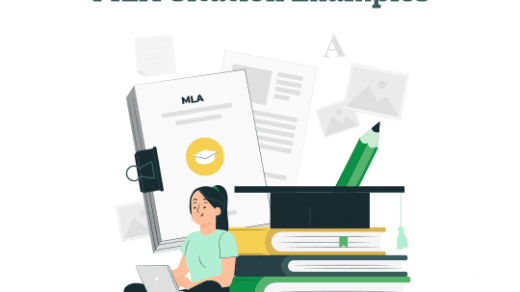In MLA 9, in-text citations follow the author–page style: include the author’s last name and the page number without a comma—either in parentheses (Smith 27) or by naming the author in the sentence and placing only the page number in parentheses. Use “et al.” for three or more authors and add short titles to distinguish multiple works.
Table of contents
-
Understanding the Author–Page Style
-
Parenthetical vs. Narrative: Which to Use and When
-
Special Cases You’ll Actually Meet
-
Style, Punctuation, and Integration
-
Quick Reference Table + Mini-Checklist
Understanding the Author–Page Style
Core idea: MLA in-text citations are designed to point precisely to the first element of the Works Cited entry (usually the author), plus the page location in the source. This keeps the flow of your prose intact while making verification easy.
What to include. In most cases you need two things:
-
Author’s surname (or the element that starts the Works Cited entry).
-
Page number(s) you are citing, no “p.” or comma—just a space: (Lee 112–13).
Two equally valid placements:
-
Parenthetical: Place both elements in parentheses at the end of the sentence but before the period: …interpretation (Morrison 45).
-
Narrative: Weave the author into the sentence and put only the page number in parentheses: Morrison argues… (45).
Why this matters. MLA values readability. Keeping citations brief and consistent makes long papers easier to follow. The in-text cue must match the Works Cited so your reader can find the full details instantly.
Typical variations you’ll face: two authors, three or more authors, no author, multiple works by the same author, corporate authors, multimedia with timestamps, and sources without page numbers. Each is solvable with short, predictable patterns you’ll see below.
Parenthetical vs. Narrative: Which to Use and When
Two routes, same destination. Both forms satisfy MLA’s requirements; choose the one that best serves your sentence.
Parenthetical style keeps your prose neutral and compact. It’s ideal when the idea matters more than the speaker:
Recent scholarship re-evaluates the role of the chorus (Hughes 76).
Narrative style puts emphasis on the source’s voice or argument, which is helpful when attributing a distinctive claim:
Hughes contends that the chorus directs audience sympathy (76).
When to prefer narrative:
-
You are synthesizing multiple sources and want to distinguish who says what.
-
The author’s name flows naturally because you’re discussing their methodology or stance.
When to prefer parenthetical:
-
You’re blending multiple citations at the end of a sentence: (Chen 52; Mendez 203–04).
-
The sentence already carries heavy information and you want the citation out of the way.
Blending quotations smoothly.
-
Short quotations (fewer than four lines of prose) stay inside your paragraph with the citation after the closing quotation marks but before the period: “text” (Rivera 9).
-
Block quotations (four+ lines) are indented and period comes before the citation. Then add (Rivera 9) after the punctuation.
These placements keep the visual cue consistent and prevent your citation from getting lost.
Special Cases You’ll Actually Meet
Multiple authors
-
Two authors: include both surnames joined by “and”: (Ng and Roy 218); or Ng and Roy argue… (218).
-
Three or more authors: use first author + et al. (Khan et al. 77).
-
Same surname in your sources: add initials or first names in the text to avoid confusion, or use titles to clarify when needed.
No author (or no individual author listed)
If the Works Cited entry begins with a title, use a shortened version of that title in the citation. Put quotation marks for articles/webpages and italics for books or standalone works: (“Mapping Migration” 4) or (Digital Culture 143). Choose the first significant word(s) so the link to Works Cited is obvious.
Multiple works by the same author
Include a shortened title after the surname to distinguish the source: (Austen, Persuasion 98) vs. (Austen, Emma 61). In narrative form: In Persuasion, Austen suggests… (98).
Corporate or group authors
Use the organization’s name as the author: (World Health Organization 12). If the name is long, shorten it in the Works Cited and in the in-text citation consistently; in prose, you can introduce the full name once and then shorten thereafter.
Classic literature and sacred texts
Use division numbers that are standard for the work so page differences across editions don’t matter.
-
Plays: (Shakespeare, Hamlet 1.3.14–18) → Act.Scene.Lines.
-
Poetry: Use line numbers if available: (Keats 41–44).
-
Sacred texts: Give version on first mention, then book.chapter.verse afterward as appropriate.
Sources without page numbers
For many digital sources, omit page numbers. Use a section heading or other stable locator if it truly helps: (“Results” section). For time-based media (video, podcast, film), provide timestamps: (00:03:14–00:03:36). Do not invent paragraph numbers unless the source provides them.
Indirect sources (quoted in another source)
When you must cite a source you haven’t accessed directly, make that clear. Reference the original author in your prose and then use “qtd. in” to point to the source you actually read: Freud notes… (qtd. in Marcus 58). It’s better, when possible, to consult the original.
Multiple citations in one set of parentheses
Separate different sources with semicolons: (Diaz 14; Mota 77–79; Li 203). This is useful when triangulating a claim or mapping consensus.
Style, Punctuation, and Integration
Keep punctuation predictable. The citation goes before the period for standard sentences: …as shown (Brooks 21). Periods go after the citation; commas do not appear between author and page; and question marks/exclamation points follow the citation unless they belong to the quoted material.
Match your first Works Cited element. If your entry begins with a title or group name, your in-text cue must echo that exact element. Consistency is what allows readers to jump between text and bibliography without friction.
Avoid over-citation. Cite where the claim originates or where the quotation ends. If a paragraph paraphrases the same page from the same source, a clear narrative signal at the start plus one parenthetical at the end may suffice. When the page changes or you mix sources, refresh the citation.
Signal phrases for flow. Verbs like argues, contends, demonstrates, observes, concedes help readers track who is speaking. Example: As Delgado demonstrates, early drafts reveal structural changes (44). Alternating between narrative and parenthetical modes keeps prose lively and prevents repetitive parentheses.
Integrate numbers and ranges correctly. Use en dashes for ranges (134–35) and follow the source’s numbering system (pages, lines, scenes). For nonconsecutive locations, use commas: (19, 28, 44). For multiple volumes, add the volume number before the page when needed: (2: 315).
Quotations and capitalization. When quoting, preserve the original capitalization unless you integrate the quote mid-sentence; in that case, you may adjust capitalization for grammatical fit, using brackets to mark changes if necessary.
Common pitfalls to avoid (and what to do instead):
-
Comma between name and page → wrong: (Ng, 41); correct: (Ng 41).
-
Citation after the period in standard prose → tends to be wrong; place it before the period.
-
Using “ibid.” → MLA does not use ibid.; repeat the author–page details.
-
Inventing locators for web texts → do not make them up; omit if none exist.
Quick Reference Table + Mini-Checklist
At-a-glance patterns you’ll use most days:
| Scenario | Parenthetical form | Narrative form |
|---|---|---|
| One author | (Singh 64) | Singh notes… (64). |
| Two authors | (Reed and Flores 117) | Reed and Flores contend… (117). |
| Three+ authors | (Okafor et al. 9) | Okafor et al. find… (9). |
| No author (article/webpage) | (“Urban Heat” 3) | In “Urban Heat,” researchers show… (3). |
| Same author, different works | (Garcia, Origins 211) vs. (Garcia, Echoes 54) | In Origins, Garcia argues… (211). |
| Corporate author | (National Research Council 45) | The National Research Council reports… (45). |
| Time-based media | (00:05:42–00:06:10) | The documentary emphasizes… (00:05:42–00:06:10). |
Mini-checklist for final edits (keep it brief and decisive):
-
Author–page only; no comma.
-
Citation before the period (except block quotes).
-
Use “et al.” for 3+ authors.
-
Short title when no author or to distinguish works.
-
No invented locators; use timestamps for media.
Style examples in context (putting it all together)
Parenthetical blend:
The later poems invert the pastoral ideal by foregrounding industrial soundscapes (Turner 88–89; Patel 203), a device that signals a break with the movement’s early aesthetics.
Narrative emphasis:
Turner rejects the view that pastoral motifs fade after mid-century, arguing instead that they recode urban textures (88–89).
Digital source without pages:
The report outlines a phased approach to school reopening (“Community Metrics”), tracking ventilation upgrades alongside testing cadence.
Classic text locator:
Stage directions in Shakespeare’s The Tempest frequently undercut Prospero’s authority (4.1.140–48), placing spectacle in conflict with mastery.
Indirect source:
Takahashi’s field interviews complicate earlier survey data (qtd. in Lewis 59) by showing how informal caregiving arrangements mask economic precarity.
Multiple items in one parenthesis:
The expansion’s long-term effects remain contested (Brooks 77; Yamada 14; Ortiz 301–02), though recent archival releases have narrowed the debate.




